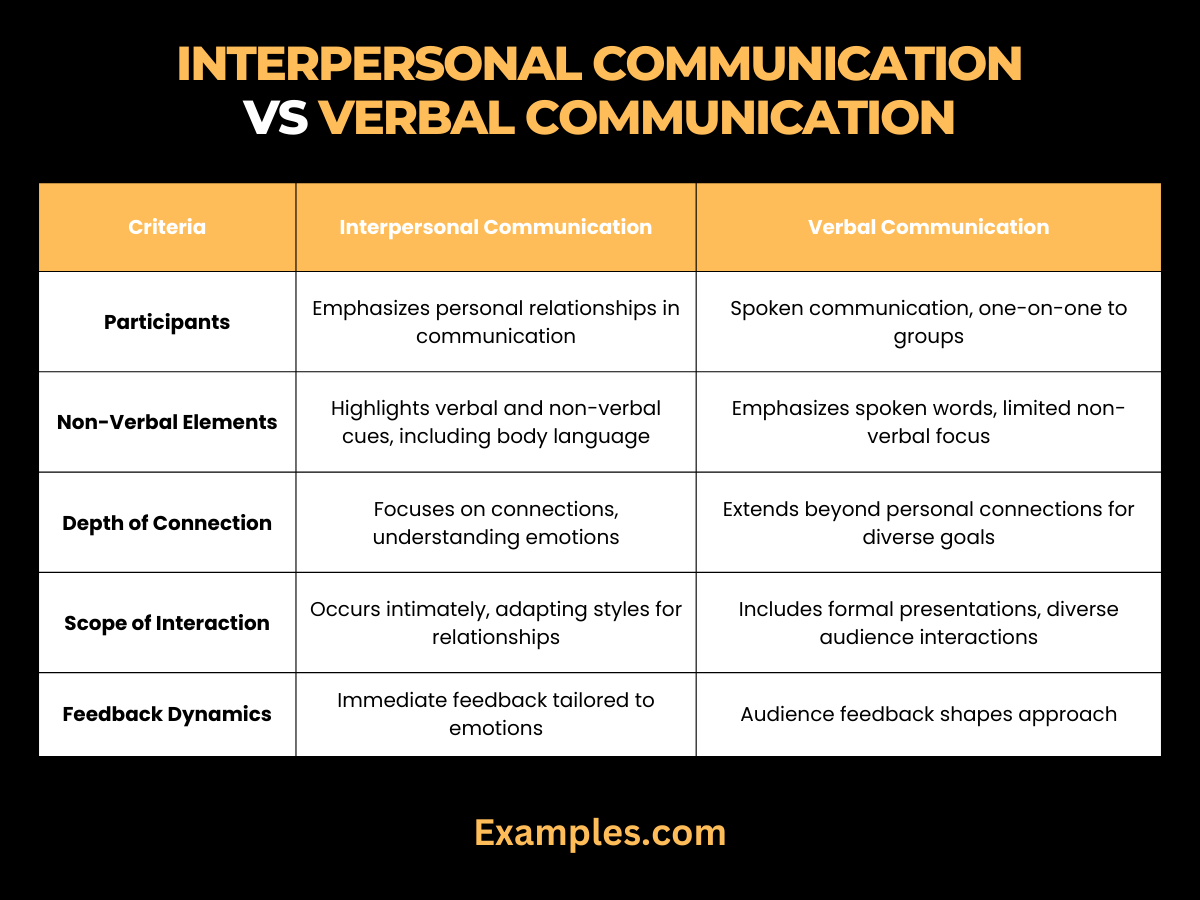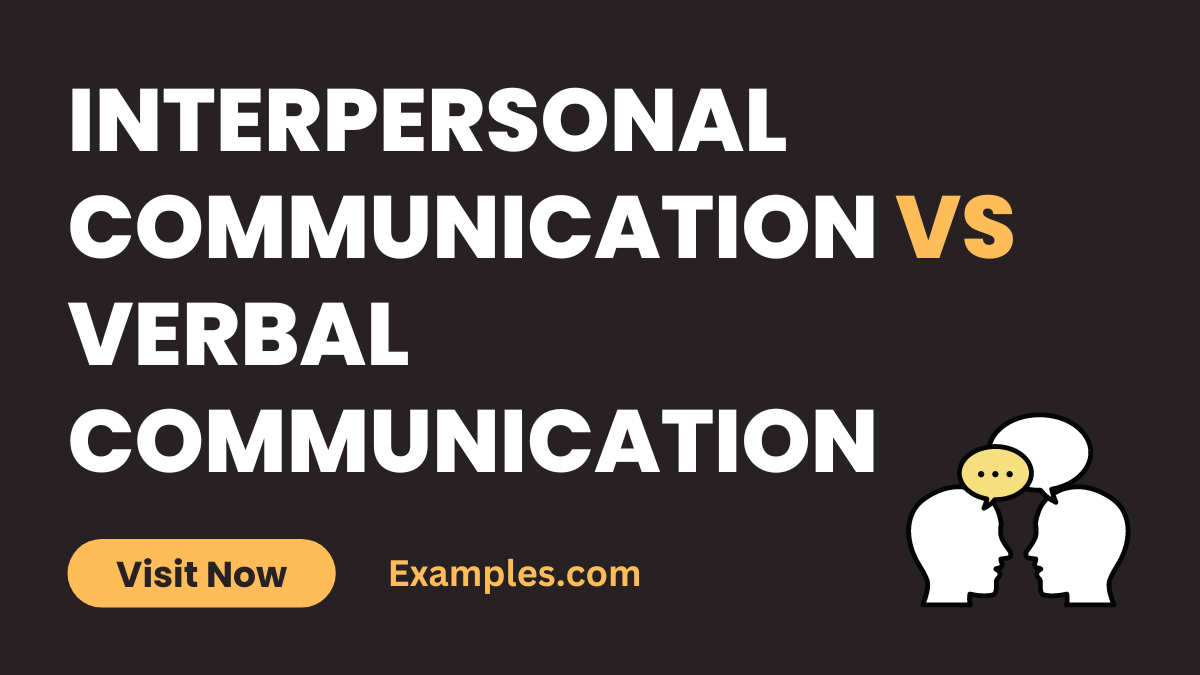Interpersonal Communication vs Verbal Communication – 9+ Examples
Embark on a comprehensive exploration of dialogue dynamics with our guide on Interpersonal Communication vs Verbal Communication. Delve into the realms of nuanced expressions and spoken words, unraveling the distinctions that shape meaningful connections and articulate exchanges. This guide provides valuable insights, enriched with practical “Communication Examples,” offering a deep dive into the intricacies of interpersonal interactions and the broader spectrum of verbal communication in various social contexts.
Difference between Interpersonal Communication and Verbal Communication?

Embark on a nuanced journey as we dissect and compare the intricacies between Interpersonal and Verbal Communication through a detailed table:
| Criteria | Interpersonal Communication | Verbal Communication |
|---|---|---|
| Participants | Involves communication between individuals, emphasizing personal relationships. | Encompasses any communication through spoken words, extending from one-on-one interactions to group settings. |
| Non-Verbal Elements | Emphasizes both verbal and non-verbal cues, including body language, gestures, and facial expressions. | Primarily centers on spoken words, with limited emphasis on non-verbal elements, such as tone and pitch. |
| Depth of Connection | Focuses on building personal connections, understanding emotions, and nurturing relationships. | Extends beyond personal connections to convey information, ideas, and sentiments, catering to various communication objectives. |
| Scope of Interaction | Often occurs within intimate, personalized contexts, adapting communication styles to suit individual relationships. | Spans a broader spectrum, encompassing formal presentations, public speaking, and diverse interactions with varied audiences. |
| Feedback Dynamics | Immediate feedback is tailored to the nuances of personal relationships and emotional expressions. | Feedback is received from the audience or participants, shaping the speaker’s approach and adjusting communication based on the context. |
| Adaptability in Styles | Communication styles are personalized, adjusting to the comfort levels and preferences of the individuals involved. | Involves adapting communication styles based on the context, audience, and purpose, showcasing versatility in expression. |
| Examples in Daily Life | Everyday interactions include one-on-one conversations, personal interactions, and relationship-building moments. | Examples encompass formal presentations, public speeches, conversations, interviews, and a myriad of verbal exchanges in daily life. |
This comprehensive guide unveils the distinctive features of both Interpersonal and Verbal Communication, providing insights into their varied contexts and applications in diverse social scenarios.
10 Examples of Interpersonal Communication
Embark on a journey of meaningful connections with these 10 exemplary instances of Interpersonal Communication. Each showcases the art of effective dialogue, offering insights into personal interactions that shape relationships and understanding.
- Active Listening: Demonstrate empathy through attentive listening; respond with understanding to enhance the connection.
- Expressing Empathy: Show genuine concern by saying, “I understand your feelings; your perspective matters to me.”
- Conflict Resolution: Navigate conflicts openly; find common ground for resolution, fostering harmony.
- Non-Verbal Affirmation: Use non-verbal cues like smiles to express affection and reinforce emotional connections.
- Effective Questioning: Encourage engagement with open-ended questions, creating richer, more insightful conversations.
- Building Trust: Cultivate trust through transparent communication, building a strong foundation.
- Setting Boundaries: Clearly communicate personal boundaries for mutual understanding and respect.
- Giving Constructive Feedback: Provide feedback with tact and specificity, guiding improvement without defensiveness.
- Expressing Gratitude: Show appreciation by saying, “Thank you for your efforts; your contributions are invaluable.”
- Apologizing Sincerely: Apologize sincerely when needed, acknowledging mistakes for relational harmony.
10 Examples of Verbal Communication
Dive into the realm of spoken expressions with these 10 exemplary instances of Verbal Communication. Explore the power of words to convey information, ideas, and emotions, showcasing the versatility of spoken interactions in various contexts.
- Formal Presentations: Convey information with clarity and authority, engaging audiences through structured verbal delivery.
- Public Speaking: Inspire and influence through impactful speeches, using persuasive language and compelling narratives.
- Casual Conversations: Connect on a personal level with informal dialogues, adapting language to suit everyday interactions.
- Phone Conversations: Communicate effectively over the phone, emphasizing tone and articulation for clear understanding.
- Interviews: Convey professionalism in interviews, showcasing communication skills, clarity, and confidence.
- Group Discussions: Participate actively in group discussions, contributing ideas and perspectives to foster collaboration.
- Debates: Express opinions persuasively in debates, using eloquence and argumentative skills to influence opinions.
- Negotiations: Achieve mutual agreements through effective negotiation, using articulate language to convey positions.
- Teaching and Training: Impart knowledge dynamically through verbal instruction, engaging learners with clear communication.
- Storytelling: Captivate audiences through storytelling, using vivid language and expressive delivery for narrative impact.
Comparison between Interpersonal Communication and Verbal Communication
Embark on a detailed exploration of the differences between Interpersonal Communication and Verbal Communication in this comprehensive point-by-point guide:
1. Interaction Dynamics:
- Interpersonal Communication: Involves direct interaction between two or more individuals, emphasizing personal connections through verbal and non-verbal cues.
- Verbal Communication: Focuses specifically on the exchange of information through spoken words, irrespective of the interpersonal context.
2. Participants and Relationships:
- Interpersonal Communication: Engages participants in dynamic exchanges, allowing for the expression of thoughts, emotions, and shared experiences.
- Verbal Communication: Extends beyond personal connections, encompassing any communication where spoken words are the primary medium.
3. Non-Verbal Elements:
- Interpersonal Communication: Incorporates non-verbal cues such as body language, facial expressions, and gestures, enriching the depth of communication.
- Verbal Communication: Primarily relies on spoken words, with potentially less emphasis on non-verbal elements, making it less nuanced in conveying emotions.
4. Communication Channels:
- Interpersonal Communication: Utilizes various channels such as face-to-face interactions, calls, and personalized messages, integrating verbal and non-verbal elements.
- Verbal Communication: Primarily occurs through spoken language, encompassing conversations, speeches, and presentations, with a focus on the spoken word.
5. Objective and Purpose:
- Interpersonal Communication: Primarily geared towards building relationships, sharing emotions, resolving conflicts, and fostering mutual understanding.
- Verbal Communication: Aims to convey information, express thoughts, persuade, or entertain, with a focus on the spoken aspect of communication.
6. Adaptability to Participants:
- Interpersonal Communication: Adapts to the unique needs and preferences of individuals, considering the relational context and personal dynamics.
- Verbal Communication: Requires adaptability to cater to diverse audiences but may follow a more standardized approach, especially in public speaking or formal settings.
7. Daily Life Scenarios:
- Interpersonal Communication: Encompasses everyday conversations with friends, family, and colleagues, shaping personal relationships and shared moments.
- Verbal Communication: Extends to various scenarios, including casual conversations, business meetings, public speeches, and formal presentations.
8. Feedback Dynamics:
- Interpersonal Communication: Involves immediate and personalized feedback, allowing for real-time adjustments based on verbal and non-verbal cues.
- Verbal Communication: Feedback may vary in immediacy, with real-time adjustments more feasible in interpersonal contexts compared to formal or one-way verbal communication.
9. Role in Social Dynamics:
- Interpersonal Communication: Integral to shaping social dynamics, influencing the quality of personal relationships and connections within a broader social context.
- Verbal Communication: Influences social dynamics at various levels, contributing to public perceptions, attitudes, and collective understanding.
10. Expression of Emotions:
- Interpersonal Communication: Provides a rich platform for expressing emotions through both verbal and non-verbal means, fostering a deeper emotional connection.
- Verbal Communication: Expresses emotions primarily through spoken words, potentially with a lesser degree of emotional depth compared to interpersonal interactions.
By understanding the distinctions between interpersonal and verbal communication, individuals can navigate diverse communication scenarios, leveraging the unique dynamics each form offers for effective and meaningful exchanges.
Relationship between Interpersonal Communication and Verbal Communication
Embark on a detailed journey to understand the nuanced relationship between Interpersonal Communication and Verbal Communication, exploring key differentiators through comprehensive points:
1. Communication Dimensions:
- Interpersonal Communication: Encompasses both verbal and non-verbal elements, emphasizing personal connections and shared experiences.
- Verbal Communication: Focuses specifically on spoken words, regardless of the interpersonal context, emphasizing the role of language.
2. Participants and Connections:
- Interpersonal Communication: Involves direct interaction between individuals, fostering dynamic connections through both verbal and non-verbal cues.
- Verbal Communication: Extends beyond personal connections, involving communication where the primary medium is spoken language.
3. Expressive Nuances:
- Interpersonal Communication: Incorporates a rich array of non-verbal cues such as body language, facial expressions, and gestures, adding depth to the expression of thoughts and emotions.
- Verbal Communication: Primarily relies on spoken words, potentially offering less nuanced expressions compared to interpersonal communication.
4. Communication Channels:
- Interpersonal Communication: Utilizes various channels like face-to-face interactions, calls, and personalized messages, blending verbal and non-verbal components.
- Verbal Communication: Primarily occurs through spoken language, encompassing conversations, speeches, and presentations with a primary focus on verbal expression.
5. Purposeful Objectives:
- Interpersonal Communication: Primarily geared towards building and maintaining relationships, sharing emotions, resolving conflicts, and fostering mutual understanding.
- Verbal Communication: Aims to convey information, express thoughts, persuade, or entertain, highlighting the spoken aspect of communication.
6. Adaptability to Participants:
- Interpersonal Communication: Adapts to the unique needs and preferences of individuals, considering the relational context and personalized dynamics.
- Verbal Communication: Requires adaptability to diverse audiences, but may follow a more standardized approach, especially in public speaking or formal settings.
7. Everyday Life Scenarios:
- Interpersonal Communication: Encompasses everyday conversations with friends, family, and colleagues, shaping personal relationships and shared moments.
- Verbal Communication: Extends to various scenarios, including casual conversations, business meetings, public speeches, and formal presentations.
8. Feedback Dynamics:
- Interpersonal Communication: Involves immediate and personalized feedback, allowing for real-time adjustments based on both verbal and non-verbal cues.
- Verbal Communication: Feedback dynamics may vary, with real-time adjustments more feasible in interpersonal contexts compared to formal or one-way verbal communication.
9. Social Dynamics Influence:
- Interpersonal Communication: Integral to shaping social dynamics, influencing the quality of personal relationships and connections within a broader social context.
- Verbal Communication: Influences social dynamics by contributing to public perceptions, attitudes, and collective understanding, albeit with a potentially broader impact.
10. Emotional Expression:
- Interpersonal Communication: Provides a comprehensive platform for expressing emotions through both verbal and non-verbal means, fostering a deeper emotional connection.
- Verbal Communication: Expresses emotions primarily through spoken words, potentially with a slightly lesser degree of emotional depth compared to interpersonal interactions.
By delving into the dynamics of both interpersonal and verbal communication, individuals can master the art of effective expression, adapting their communication styles to diverse scenarios and cultivating meaningful connections.



